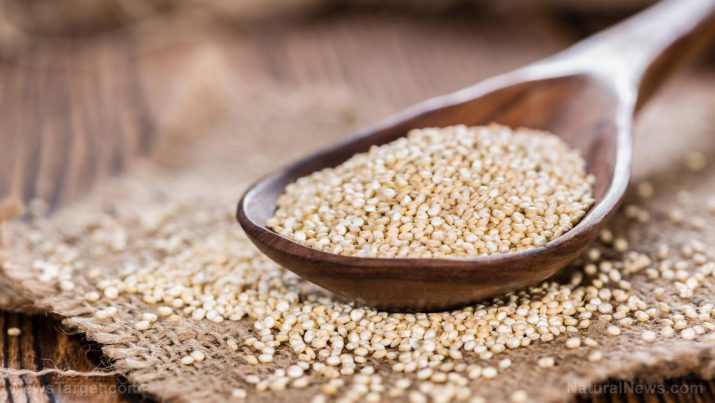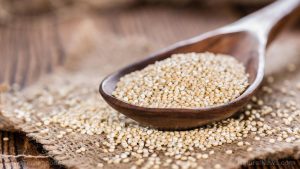
Quinoa – sources, health benefits, nutrients, uses and constituents at NaturalPedia.com
Wednesday, June 21, 2017 by Frances Bloomfield
http://www.naturalpedia.com/quinoa-sources-health-benefits-nutrients-uses-and-constituents-at-naturalpedia-com.html

Quinoa (pronounced KEEN-wah) is a grain crop originally from the areas surrounding Lake Titicaca in Peru and Bolivia. Prior to the arrival of the Spaniards, quinoa was a staple food of the pre-Columbian civilizations. Although quinoa was replaced by cereals after the Spanish conquistadors entered South America, it has since become one of the most popular and widely consumed health foods on the planet. Its reputation as a superfood is such that the Food and Agricultural Organization of the United Nations (FAO) singled out quinoa as a food with “high nutritive value” and deemed 2013 as “The International Year of Quinoa”.

List of known nutrients
Quinoa is contains all the essential amino acids and is thus a first-rate source of plant-based protein. A cup of quinoa holds eight grams or 16 percent of the recommended daily value of protein, making it a food ideal for vegetarians and vegans. As a highly nutritious grain crop, quinoa is dense with minerals, vitamins, and even antioxidants like:
- Calcium
- Copper
- Fiber
- Folate
- Iron
- Kaempferol
- Lysine
- Magnesium
- Manganese
- Phosphorus
- Potassium
- Quercetin
- Vitamin B1
- Vitamin B2
- Vitamin B3
- Vitamin B6
- Vitamin E
- Zinc
Medicinal uses for quinoa
Since quinoa is naturally gluten-free it can be enjoyed by individuals who suffer from Celiac disease or other forms of gluten intolerance. Quinoa has the added benefit of being high in the plant antioxidants quercetin and kaempferol, which makes it an average antioxidant that offers anti-inflammatory and anti-viral benefits. Regular consumption of quinoa can abate the development of conditions such as:
- Allergies
- Anemia
- Cancer
- Constipation
- Diabetes
- Diarrhea
- Fatigue
- Heart diseases and disorders
- High cholesterol
- Hypercalciuria
- Hypertension
- Kidney stones
- Osteoporosis
A one-cup serving of quinoa can deliver 15 percent of the recommended daily allowance of iron. As one of the best sources of this mineral, quinoa can lower the risk of anemia. Folate, a nutrient that can assist the body in better iron absorption, is even more abundant in quinoa than iron. Together, they make quinoa one of the top foods for preventing iron deficiency.
Quinoa is an excellent grain for bone health because it’s packed with magnesium. Similar to folate, magnesium is plays a key role in the proper absorption and metabolism of calcium.
Quinoa has a low glycemic index of 53, meaning it’s a food that is good for blood sugar control and a top choice for diabetics.
Body systems supported by quinoa
With its wide range of vitamins and minerals, quinoa can greatly boost endurance by supplying the body with iron, magnesium, zinc, and much more. These nutrients work in harmony to maintain and strengthen numerous body systems and organs, which include:
- Bones
- Digestive system
- Heart
- Kidneys
- Liver
- Muscles
- Skin
Ways to use quinoa
Quinoa is easy to incorporate into almost any diet. The simplest way is to substitute the rice part of a meal with quinoa. Since quinoa exploded in popularity, however, there have been countless recipes that have used quinoa as the prime ingredient or as an additional component. These range from quinoa pancakes to quinoa and chickpea burgers to quinoa porridge to vegetarian casserole.
Note that quinoa has phytic acid, a substance that acts as a mineral blocker and inhibits proper absorption. Soaking or sprouting quinoa before cooking it will cut down on phytic acid. One other advantage of soaking is that it will rid quinoa of saponin, a mildly toxic substance that will make quinoa taste bitter or soapy.
Where to learn more
- Quinoa nutrition – why quinoa can help you lose weight and improve your health
- 8 Amazing Health Benefits Of Eating Quinoa
- Quinoa Gives the Perfect Protein Source to Vegetarians and Vegans
- Quinoa’s many health benefits
- Quinoa is a high source of protein with tremendous health benefits
Summary
Quinoa is an excellent source of iron and can lower the risk of anemia.
It is also rich in folate.
Quinoa promotes bone health.
The grain has a low glycemic index, making it an ideal option for diabetics.
Sources include:
WHFoods.org
AuthorityNutrition.com
Well-BeingSecrets.com
Health.com
BBCGoodFood.com
Tagged Under: Tags: Quinoa





